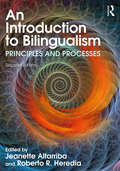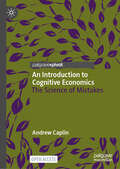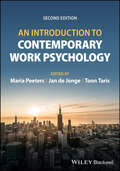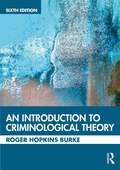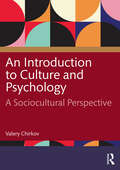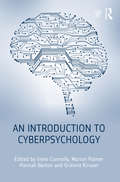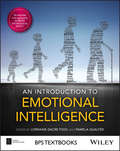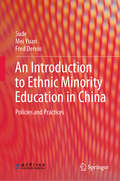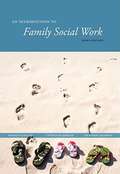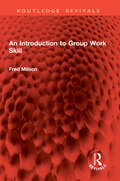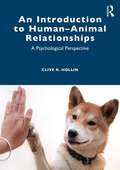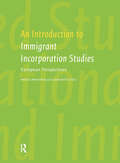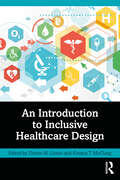- Table View
- List View
An Introduction to Behavior Analysis
by Derek D. Reed Florence D. DiGennaro Reed Gregory J. MaddenExplore a fascinating introductory treatment of the principles of behavior analysis written by three leading voices in the field An Introduction to Behavior Analysis delivers an engaging and comprehensive introduction to the concepts and applications of behavior analysis for students of behavior analysis. Written from the ground up to capture and hold student interest, the book keeps its focus on practical issues. This book offers readers sound analyses of Pavlovian and operant learning, reinforcement and punishment, motivation and stimulus control, language and rule-following, decision-making and clinical behvior analysis. With fully up to date empirical research references and theoretical content, An Introduction to Behavior Analysis thoroughly justifies every principle it describes with empirical support and explicitly points out where more data are required. The text encourages students to analyze their own experiences and some foundational findings in the field in a way that minimizes jargon and maximizes engagement. Readers will also benefit from the inclusion of: A clear articulation and defense of the philosophical assumptions and overarching goals of behavior analysis. A thorough description of objective data collection, experimental methods, and data analysis in the context of psychology An exploration of the core principles of behavior analysis, presented at a level comprehensible to an introductory audience A broad array of principles that cover issues as varied as language, substance-use disorders, and common psychological disorders Perfect for students taking their first course in behavior analysis or behavior modification, An Introduction to Behavior Analysis will also earn a place in the libraries of students pursuing certification through the Behavior Analysis Certification Board or taking courses in the applied psychological sciences.
An Introduction to Bilingualism: Principles and Processes
by Jeanette Altarriba and Roberto R. HerediaThe study of bilingualism and all of its aspects – from theory and models to social approaches and their practical applications – forms the cornerstone of the 2nd edition of this work. The chapters cover the latest advancements in the domains of psycholinguistics, neuroscience, creativity, and executive functioning. Contributions, new to this edition, offer the reader the most up-to-date research on lifespan and developmental issues. The work also provides insight into how human language is processed by all, not just by bilingual and multilingual speakers.This text is ideal for senior undergraduate and graduate courses in psycholinguistics and the psychology of language, especially those with an emphasis on bilingualism or second language learning.
An Introduction to Catholic Ethics since Vatican II
by Andrew KimThis introduction provides a comprehensive overview of the development of Catholic ethics in the wake of the Second Vatican Council (1962–5), an event widely considered crucial to the reconciliation of the Catholic Church and the modern world. Andrew Kim investigates Catholic responses to questions of moral theology in all four principal areas: Catholic social teaching, natural law, virtue ethics, and bioethics. In addition to discussing contemporary controversies surrounding abortion, contraception, labor rights, exploitation of the poor, and just war theory, he explores the historical sources of the Catholic worldview. Beginning with the moral vision revealed through the person of Jesus Christ and continuing with elaborations on this vision from figures such as Augustine and Aquinas, this volume elucidates the continuity of the Catholic moral tradition. Its balance of complexity and accessibility makes it an ideal resource for both students of theology and general readers.
An Introduction to Civics and Citizenship Education: A Machine-Generated Literature Overview
by Keith HeggartThis book serves as a starting point for pre-service teachers and researchers by providing a concise and thorough summary of key themes within the field of civics and citizenship education. The field of civics and citizenship education is both complex and contested in local and international jurisdictions. It is also a key site for political and policy interventions by governments and other interested parties. While this activity makes the field a vibrant one, it also means that it can be challenging for teachers and researchers to enter and understand the ongoing debates and discussions and the implications these present for their research and educational practice. The book begins with a detailed examination of the history of civics and citizenship education from a variety of perspectives and in different locations. It recognizes and documents how the place and importance of civics and citizenship education has changed over the last century and how this has been realized in various educational initiatives. It also examines the current state of educational and policy-level initiatives in civics and citizenship education, noting the differences between different state and country approaches. This book also undertakes a detailed consideration of the different typologies of civics and citizenship education that have been formulated by various researchers, including notions like justice-oriented citizenship, activist citizenship, and critical citizenship. It examines the theoretical foundations of both active citizenship education and global citizenship education and how these have been enacted in school settings. Furthermore, it examines the place of citizenship in higher education institutions and non-formal educational settings, including practices and statements about the importance of developing global citizenship in these arenas. It also presents a number of different case studies showcasing the variety of approaches to civics and citizenship education and discusses the opportunities and challenges educators and researchers face when researching and implementing it.
An Introduction to Cognitive Economics: The Science of Mistakes
by Andrew CaplinThis book introduces readers to “cognitive economics,” a rapidly emerging interdisciplinary science built on economic, psychological, and data scientific foundations. Throughout the book, economist Andrew Caplin provides new approaches to help scholars collaborate and solve problems that can shape economic outcomes and bridge the gap between theoretical knowledge and the real world. Divided into two parts, the first section brings readers up to speed on economic concepts that underlie decision-making mistakes, such as utility functions, subjective beliefs, and costs of learning. It also explores real-world applications, including improvements in legal decision-making, online privacy protection, and optimizing human-AI collaboration. The book also discusses the future impact of AI on the workforce and emphasizes the need for decision-making skills and financial literacy in navigating this evolving landscape. In the second section of the book, Caplin addresses the barriers to progress within social sciences, advocating for interdisciplinary cooperation and innovative measurement techniques to advance the field. The book invites readers to contribute to the development of cognitive economics. Whether you are a socially-conscious and hard-working citizen, business leader, scholar, or policymaker, this book will help you understand why cognitive economics matters to you and how you can contribute to its takeoff. This book is available open access, which means it is freely available online.
An Introduction to Contemporary Work Psychology
by Jan De Jonge Maria C.W. Peeters Toon W. TarisThis is the first comprehensive overview of work psychology, with coverage of classic models, current theories, and contemporary issues affecting the 21st-century worker. Examines the positive aspects of work-motivation, performance, creativity, and engagement--instead of focusing only on adverse effectsEdited by leaders in the field with chapters written by a global team of experts from the US, UK, Europe, and AustraliaDiscusses topics such as safety at work, technology, working times, work-family interaction, working in teams , recovery, job demands and job resources, and sickness absenceSuitable for advanced courses focused on work psychology as a sub discipline of work and organizational psychologyDidactic features include questions for discussion, boxes with practical applications, further reading sections, and a glossary
An Introduction to Contemporary Work Psychology
by Jan De Jonge Maria C. W. Peeters Toon TarisAN INTRODUCTION TO CONTEMPORARY WORK PSYCHOLOGY A fully updated edition of the definitive textbook Work psychology is the study of work behavior and the psychological dimensions that both produce and result from it. It has developed in recent decades into a field that takes a comprehensive view of 21st century workers and their psychological context and condition. Now fully updated to reflect the latest research and practical insights, it promises to continue as an indispensable resource for advanced courses in work psychology. Readers of the second edition of An Introduction to Contemporary Work Psychology will find: Chapters written by a global team of experts Overview of classic and current theories that comprise Work Psychology Detailed discussion of topics such as leadership, emotion work, sustainable careers, job crafting and the future of work A unique focus on positive aspects of work, including motivation, engagement, personal resources and positive workplace interventions An Introduction to Contemporary Work Psychology is ideal for advanced undergraduate and graduate students enrolled in work psychology courses, as well as for students or researchers looking for a reference or introduction to the subject. “Understanding work from various psychological perspectives has become highly relevant for all those involved and interested in the diverse and changing nature of work-life. This book is a treasury of what is important to know of current work psychology. It is timely, comprehensive, and enjoyable reading. Editors and authors have done great job and now it is time for readers to enjoy this book and its many perspectives to the world of contemporary work and organizational psychology.” —Jari Hakanen, PhD, Research professor, Finnish Institute of Occupational Health
An Introduction to Criminological Theory
by Roger Hopkins BurkeThis book provides a comprehensive and up-to-date introduction to criminological theory for students taking courses in criminology at both undergraduate and postgraduate level. Building on previous editions and the previous companion text, this book presents the latest research and theoretical developments in a socio-political context.All major theoretical perspectives are considered, including: classical criminology, biological and psychological positivism, labelling theories, feminist criminology, critical criminology and left realism, situation action theories, desistance theories, social control theories, the risk society, postmodern condition, and terrorism. The new edition has been updated and revised over seven parts to include full chapters on key topics, such as Bourdieau and criminology, narrative criminology, cultural victimology, southern theory and criminology, green and species criminology, critical race theory, convict and abolitionist and convict criminologies, and ultra-realist criminology. These key issues are discussed in the context of debates about the fragmentation of modernity and the postmodern condition: the rise of political populism, risk, surveillance and social control, conspiracy theories, post-truth society and speculation about living in post–COVID-19 society, and the future of neoliberalism.Supplemented with chapter summaries, critical thinking questions, policy implications, a full glossary of terms and theories, and a timeline of criminological theory, this book will appeal to undergraduate and postgraduate students of criminology, sociology, and politics, and is essential reading for advanced students of criminology looking for a way to engage with contemporary themes and concepts in theory.
An Introduction to Criminological Theory (Criminal Justice: Contemporary Literature in Theory and Practice)
by Roger Hopkins BurkeFirst Published in 1997. Routledge is an imprint of Taylor & Francis, an informa company.
An Introduction to Critical Social Psychology
by Dr Alexa Hepburn'this book provides an excellent introduction to contemporary Critical Social Psychology, which anyone exploring the field would do well to read.' - Psychology in Society 'a very accessible introduction... lively and engaging.... Discussion questions are uncharacteristicaly thought-provoking, while practical exercises also seem better considered than one comes to expect from similar primers, suggesting a successful future as a core text in social psychology courses' - The Psychologist 'Erudition, sagacity, patience and scholarship radiate from this book. This is an excellent introduction to the various strands of critical thinking to emanate primarily from England, and, to some extent, from continental Europe. Anyone interested in learning more about the discursive side of critical psychology will find in this book an excellent guide. I recommend this book to all psychologists interested in critical perspectives' - Journal of Community and Applied Psychology A critical approach depends on a range of often-implicit theories of society, knowledge, as well as the subject. This book shows the crucial role of these theories for directing critique at different parts of society, suggesting alternative ways of doing research, and effecting social change. It includes chapters from the perspectives of social cognition, Marxism, psychoanalysis, discourse and rhetoric, feminism, subjectivity and postmodernism. In each case, the strengths and weaknesses of each perspective are highlighted, the ideas are linked to real world issues by a range of practical exercises, and guidance is given to further reading.These chapters will cover the work of diverse thinkers from within social psychology, such as Billig, Gergen, Kitzinger, Parker, Potter, Shotter, Walkerdine and Wetherell, and from outside, such as Butler, Derrida, Foucault, Haraway, Lyotard, Marx and Rose. An Introduction to Critical Social Psychology provides a systematic, integrated and accessible introduction to social psychology as a critical discipline. Consequently, it will be key reading for undergraduates and postgraduates studying Critical Social Psychology, and useful additional reading for postgraduates studying theoretical psychology and qualitative methods.
An Introduction to Culture and Psychology: A Sociocultural Perspective
by Valery ChirkovThe book offers an innovative introduction to culture and psychology, taking a sociocultural perspective to understand the complexities of culture-mind-behaviour interactions.In this book, the author emphasizes the dynamic relationship of the culture and the mind, outlining how organized sociocultural models regulate actions and practices across different domains of people’s lives, such as parenting, education, communication, and acculturation. Each chapter features chapter synopsis, boxed examples, a glossary of key terms, reflective questions, and recommended reading to help students engage further with the material. The book includes a range of cross-cultural case study examples and discussions which offer insights into the connections between culture, human psyche, and behaviour.An Introduction to Culture and Psychology is essential reading for undergraduate students taking culture and psychology courses. It can also be of interest to students and young scholars of psychology, anthropology, sociology, communication, and other related disciplines.
An Introduction to Cyberpsychology
by Irene Connolly, Palmer Marion, Barton Hannah and Kirwan GráinneAn Introduction to Cyberpsychology is the first book to provide a student-oriented introduction to this rapidly growing and increasingly studied topic. It is designed to encourage students to critically evaluate the psychology of online interactions, and to develop appropriate research methodologies to complete their own work in this field. The book is comprised of four main sections: An overview of cyberpsychology and online research methodologies Social psychology in an online context The practical applications of cyberpsychology The psychological aspects of other technologies. Each chapter includes: Explanations of key terms and a glossary to facilitate understanding Content summaries to aid student learning Activity boxes, discussion questions and recommended reading to guide further study. Further resources for students and instructors are available on the book’s companion website, including audio and video links, essay questions, a multiple-choice test bank, and PowerPoint lecture slides. Uniquely combining a survey of the field with a focus on the applied areas of psychology, the book is designed to be a core text for undergraduate modules in cyberpsychology and the psychology of the internet, and a primer for students of postgraduate programs in cyberpsychology.
An Introduction to Cyberpsychology (BPS Core Textbooks Series)
by Gráinne Kirwan, Irene Connolly, Hannah Barton, and Marion PalmerAn Introduction to Cyberpsychology provides a comprehensive introduction to this rapidly growing discipline. Fully updated in its second edition, the book encourages students to critically evaluate the psychology of online interactions and to develop appropriate research methodologies to complete their own work in this field.The book examines cyberpsychology and online research methodologies, social psychology in an online context, practical applications of cyberpsychology, and the psychological aspects of other technologies. This new edition has been carefully updated to include additional coverage of: Expanded content relating to major developments in the field and new content on gaming and screentime A new chapter examining the relationship between older adults and technology Cyberpsychology in focus feature boxes in each chapter that examine topics in depth Interviews with professionals working in fields relating to cyberpsychology Each chapter includes key terms and a glossary, content summaries, discussion questions, and recommended reading to guide further study.Supported by extensive online resources for students and instructors, this authoritative book is an essential core text for undergraduate modules in cyberpsychology, and an ideal primer for students of postgraduate programs in cyberpsychology.To view the additional student and instructor resources for this book, please visit bpscoretextbooks.routledge.com
An Introduction to Data Analysis Using IBM SPSS
by Lokesh JasraiThis textbook elaborates on the basic understanding and application of statistical tests and data analysis using hypothetical datasets and SPSS version 22.0. It presents step-by-step processes and to-the-point interpretation for quick assimilation and comprehension.Data Analysis Using SPSS Begins with the stages of data entry and goes on till editing and data visualization. Takes the readers through descriptive statistics, frequency, univariate, bivariate and regression analysis, cross-tabulation, linear models and non-parametric test procedures. Presents information through dialog boxes and tabular charts, and also incorporates important formulae, calculations and illustrations of sample data for an in-depth understanding of concepts and results. Can be used as a textbook as well as a reference book as it helps to build conceptual understanding, gaining software skills, and communicates data and its insights to accomplish research assignments, research/capstone projects and PhD research work. With comprehensive coverage, this book would be useful to the students, researchers and teachers of the various social sciences disciplines like Psychology, Sociology, Education, Social Work, Agriculture Management and other allied subjects. It would also be an invaluable companion to professionals and data scientists working in the field of analytics.
An Introduction to Data Science
by Jeffrey S. Saltz Jeffrey Morgan StantonAn Introduction to Data Science is an easy-to-read, gentle introduction for advanced undergraduate, certificate, and graduate students coming from a wide range of backgrounds into the world of data science. After introducing the basic concepts of data science, the book builds on these foundations to explain data science techniques using the R programming language and RStudio® from the ground up. Short chapters allow instructors to group concepts together for a semester course and provide students with manageable amounts of information for each concept. By taking students systematically through the R programming environment, the book takes the fear out of data science and familiarizes students with the environment so they can be successful when performing advanced functions. The authors cover statistics from a conceptual standpoint, focusing on how to use and interpret statistics, rather than the math behind the statistics. This text then demonstrates how to use data effectively and efficiently to construct models, predict outcomes, visualize data, and make decisions. Accompanying digital resources provide code and datasets for instructors and learners to perform a wide range of data science tasks.
An Introduction to Data Science
by Jeffrey S. Saltz Jeffrey Morgan StantonAn Introduction to Data Science is an easy-to-read, gentle introduction for advanced undergraduate, certificate, and graduate students coming from a wide range of backgrounds into the world of data science. After introducing the basic concepts of data science, the book builds on these foundations to explain data science techniques using the R programming language and RStudio® from the ground up. Short chapters allow instructors to group concepts together for a semester course and provide students with manageable amounts of information for each concept. By taking students systematically through the R programming environment, the book takes the fear out of data science and familiarizes students with the environment so they can be successful when performing advanced functions. The authors cover statistics from a conceptual standpoint, focusing on how to use and interpret statistics, rather than the math behind the statistics. This text then demonstrates how to use data effectively and efficiently to construct models, predict outcomes, visualize data, and make decisions. Accompanying digital resources provide code and datasets for instructors and learners to perform a wide range of data science tasks.
An Introduction to Emotional Intelligence (BPS Textbooks in Psychology)
by Lorraine Dacre Pool Pamela QualterBridges the gap between the scholarly literature and “pop-psych” books on EI Emotional Intelligence (EI) has become a topic of vast and growing interest worldwide and is concerned with the ways in which we perceive, identify, understand, and manage emotions. It is an aspect of individual difference that can impact a number of important outcomes throughout a person’s lifespan. Yet, until now there were no authoritative books that bridge the gap between scholarly articles on the subject, often published in obscure professional journals, and the kind of books found in the “pop-psych” sections of most large bookstores. This book fills that gap, addressing the key issues from birth through to old age, including the impact of EI on child development, social relationships, the workplace, and health. It is a useful introduction to the academic study of EI, including its history as a concept. Featuring contributions by an international team of EI researchers, this thought provoking and informative book offers students, educators, mental health professionals, and general readers a comprehensive, critical, and accessible introduction to state-of-the-art EI theory and research. From the historical origins of EI to its contemporary applications across an array of domains, An Introduction to Emotional Intelligence explores what the research evidence tells us about it, why it is important, and how it is measured. Throughout each chapter any potentially tricky words or concepts are highlighted and explained. And, most chapters feature activities to spur further reflection on the subject matter covered as well as ideas on how to apply aspects of EI to various questions or problems arising in the readers’ lives. Features contributions from expert authors from around the world with experience of researching and teaching EI theory and practice Makes EI concepts, foundations, research, and theory accessible to a wider audience of readers than ever before Explores EI’s roots in psychological thinking dating back to early 20th century and considers the reasons for its widespread popularity in contemporary times Reviews the latest research into the constructs of ability EI and trait EI and their validity in relation to health, wellbeing, social relationships, academic, and work performance An Introduction to Emotional Intelligence is fascinating and informative reading and a source of practical insight for students of psychology, management and leadership, education, social work and healthcare, and those working in education, health settings and in psychological counseling professions.
An Introduction to Ethnic Minority Education in China: Policies and Practices
by Fred Dervin Sude Mei YuanChinese ethnic minority education is virtually unknown to readers outside China. Based on extensive qualitative and quantitative data, this book examines the basic education policies for ethnic minorities in China and describes policy implementation. It also discusses successful case studies, restrictive factors, existing gaps and challenges as well as the associated problems, highlighting teacher training and the role of policymakers. The authors propose recommendations to address the challenges faced by Chinese education, and to develop and implement culturally sensitive basic education for ethnic minorities in the country. Offering a rare glimpse inside minority schools in different parts of the country, the book appeals to educators, scholars, decision-makers and anyone interested in diversity education (intercultural, multicultural, global education).
An Introduction to Exponential Random Graph Modeling
by Jenine K. HarrisThis volume introduces the basic concepts of Exponential Random Graph Modeling (ERGM), gives examples of why it is used, and shows the reader how to conduct basic ERGM analyses in their own research. ERGM is a statistical approach to modeling social network structure that goes beyond the descriptive methods conventionally used in social network analysis. Although it was developed to handle the inherent non-independence of network data, the results of ERGM are interpreted in similar ways to logistic regression, making this a very useful method for examining social systems. Recent advances in statistical software have helped make ERGM accessible to social scientists, but a concise guide to using ERGM has been lacking. An Introduction to Exponential Random Graph Modeling, by Jenine K. Harris, fills that gap, by using examples from public health, and walking the reader through the process of ERGM model-building using R statistical software and the statnet package.
An Introduction to Family Social Work
by Catheleen Jordan Heather Coleman Don CollinsThis text is intended for Methods/Practice with Families (Mezzo) courses in Social Work as a basic primer that introduces students to an overview of practice with families. It can also be used in Generalist Practice courses in which instructors want to emphasize work with families. Likewise, it is appropriate for paraprofessional, two-year human services programs.
An Introduction to GLBT Family Studies
by J Jerry BignerGain a better understanding of the special therapeutic issues and needs of GLBT familiesIn terms of research, GLBT families constitute a neglected segment of society. Gender and sexual orientation can make the issues in family studies even more difficult to work through. An Introduction to GLBT Family Studies tackles a challenging research topic by presenting noted experts examining the latest information on the newest type of family studies-GLBT families. This groundbreaking text explores a wide range of unique problems faced by nontraditional families, as well as issues common to traditional families that need to be approached with a GLBT perspective.Though homophobia and heterosexism constantly influence GLBT families, these factors do not necessarily overwhelm the dynamic of their basic family unit. Issues present in many traditional families are found when researching GLBT families. An Introduction to GLBT Family Studies spotlights the issues, research, and future trends that provide a foundation for the study of GLBT families. This breakthrough volume focuses not only on the obvious unique factors within GLBT families, but also on the elements encountered within families that are present regardless of sexual orientation and gender, such as physical and emotional abuse. Expert contributors present research findings on family pattern issues relating to parent-child relationships, child development, sibling relationships, family structure, intimate relationships, stepfamilies, alternative family structures, and extended family relationships. Each chapter is extensively referenced and offers possibilities for further research. An Introduction to GLBT Family Studies discusses family studies topics such as: the impact of the family of origin life course perspective transgender identity issues and the family when a spouse comes out as gay, lesbian, or bisexual a study of lesbian couples adapting genogram techniques in therapy research comparing siblings of different sexual orientations studies of patterns of responses to parental reactions to learning their offspring are gay, lesbian, or bisexual the polyamory structure to some gay men&’s familial relationships same-sex marriages and legalized relationships gay male couples&’ roles in today&’s society the impact of heterosexism on working with same-sex relationships research on long-term lesbian couplesAn Introduction to GLBT Family Studies is a valuable reference for academic researchers in family studies, marriage and family therapy, social work, and counseling; educators, upper division undergraduate and graduate students; and anyone interested in better understanding GLBT family studies.
An Introduction to Group Work Skill (Routledge Revivals)
by Fred MilsonFirst Published in 1973, An Introduction to Group Work Skill is designed to make the understanding of group work skills accessible to all- mothers, teachers, employers, as well as professional social workers. Dr Milson argues that this lengthy and imaginative excursion has been thought necessary as we are here concerned with the behaviour of people in groups which meet fairly regularly, which are small enough to provide opportunities for every member to know every other member as a person, and where there is a goal to be achieved which calls for a contribution from each.The author further argues that group work skill is composed of observation, interpretation, and action, and he proceeds to analyze each of these elements in successive chapters. This is an interesting read for students of sociology of work and social work.
An Introduction to Human–Animal Relationships: A Psychological Perspective
by Clive R. HollinAn Introduction to Human–Animal Relationships is a comprehensive introduction to the field of human–animal interaction from a psychological perspective across a wide range of themes. Hollin examines the topic of the relationships between humans and animals as seen in owning a companion animal alongside more indirect relationships such as our approaches to eating meat. The core issues under discussion include the moral and ethical issues raised in using animals for entertainment, in therapy, to keep us safe, and in sports such as horse racing. The justifications for hunting and killing animals as sport and using animals in scientific experimentation are considered. The closing chapter looks to the future and considers how conservation and climate change may influence human–animal relationships. This key text brings an important perspective to the field of human–animal studies and will be useful to students and scholars in the fields of psychology, sociology, animal welfare, anthrozoology, veterinary science, and zoology.
An Introduction to Immigrant Incorporation Studies: European Perspectives (IMISCOE Textbooks)
by Jan Rath Marco MartinielloFocusing mainly on the European experience including Eastern Europe, this important volume offers an advanced introduction to immigrant incorporation studies from a historical, empirical and theoretical perspective. Beyond incorporation theories, renowned scholars in the field explore incorporation in action in different fields, policy issues and normative dimensions.
An Introduction to Inclusive Healthcare Design
by Denise M. Linton Kiwana T. McClungAn Introduction to Inclusive Healthcare Design is a comprehensive guide to the design and facilitation of safe, healthy, equitable, and inclusive healthcare settings across a variety of scales. The book informs healthcare professionals, healthcare administrators, planners, designers in the healthcare sector, design students, and faculty about best practices and considerations for inclusive design.The primary theme for the book is design for all – considering the design of healthcare spaces through the lenses of inclusivity and social equity. Part 1 presents the reader with an overview of the variety of locations and types of healthcare settings. Part 2 provides a comprehensive overview of the principles of equitable and inclusive healthcare design and considers how these principles can be applied to the range of settings laid out in Part 1. The authors consider inclusivity-supportive infrastructure in primary and ancillary spaces within healthcare settings. Part 3 envisions the future of inclusive healthcare design, considering the integration of virtual reality and artificial intelligence, as well as addressing the ever more relevant issue of healthcare provision in settings at risk of natural disasters.

